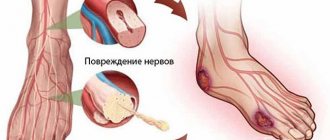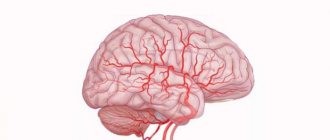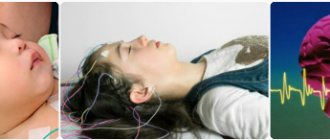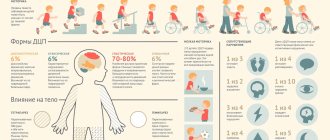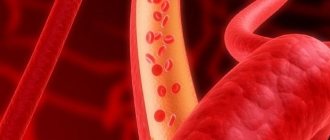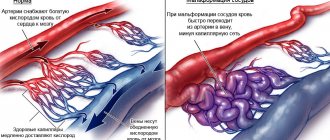21 Feb 2020 at 12:11 Complex MRI 4154
Diseases of the cardiovascular system still occupy one of the leading places among ailments leading to death or disability. A decrease in the patency of blood vessels negatively affects the quality of work not only of individual organs, but also of the entire body. One of the most dangerous manifestations that can occur in the cardiovascular system is blockage of blood vessels in the brain, lower extremities and heart.
Vascular diseases: why the disease develops
Blood clotting
Blood coagulation is the most important physiological algorithm of the body, in which many blood components participate. The reaction helps prevent blood loss when the skin or vital organs are damaged. The formed clot prevents excessive bleeding and protects against death.
The main reason for the development of pathology is the formation of blood clots. Two types of blood clots form in the human body: some form in the arteries and have a grayish color, others form in the veins and have a bright red color. Normally, clots form when tissue is damaged externally. If a clot forms in the middle of the vessel, it is said to be pathological thrombus formation. The situation is predominantly inherent in the veins, because it is there that the flow of blood is not as rapid as in the arteries. A clot in blood vessels is formed when the internal walls are damaged and blood clotting accelerates.
Blood clots most often enter large veins from the bloodstream. This is thromboembolism, when the clot did not form in the vessels, but came from the heart, abdominal or iliac artery. Thromboembolism of the lower extremities is most often recorded in combination with arrhythmia, aneurysm, and atherosclerosis.
Pathological heredity
Among the reasons leading to the development of vascular disease of the lower extremities include:
- heredity;
- pathological degeneration in connective tissues;
- hormonal imbalances in women during pregnancy or menopause;
- taking hormonal drugs;
- low physical activity;
- excess body weight;
- prolonged sitting;
- taking certain medications;
- loss of vascular elasticity.
All the reasons for the development of a pathological condition are combined as follows:
- accelerated blood clotting;
- slowing down the speed of blood flow;
- violation of the integrity of the walls of blood vessels.
Thrombus
Accelerated blood clotting leads to serious disorders:
- microcirculation is disrupted;
- blood clots of different sizes form;
- due to the formation of clots, the lumen of blood vessels decreases;
- ischemia develops.
Types of blockages
There are two types of vascular embolus in a patient: endogenous and exogenous.
Endogenous blockages are those that are created directly in the patient’s body. These include:
- Adipose tissue.
- Thrombus.
- Malignant neoplasms.
- Cancer metastases.
- Accumulation of pus during inflammatory processes.
The development of endogenous vascular emboli in a patient can be triggered by injury, surgery or an infectious disease.
Exogenous emboli are air bubbles that enter the patient’s blood during mechanical trauma, injury or medical manipulation.
Note! According to parasitologists and phlebologists, the percentage of blood vessels blocked by worms is rapidly growing. Migrating throughout the body, they can cause enormous harm to the body, blocking arterial and venous passages and thereby disrupting the circulation of lymph and blood.
The situation is complicated by the fact that oxygen starvation, which occurs when blood vessels are blocked, provokes severe intoxication of the body and often causes the death of the patient.
Symptoms of vascular diseases
Vascular diseases have common symptoms, which is why it is sometimes difficult to differentiate pathologies. You should consult a doctor if you have the following symptoms:
- The appearance of spider veins on the lower extremities. The sign signals a violation of blood flow in a specific place.
- The appearance of edema. Swelling can appear in symmetrical areas or not. The appearance of edema is not related to the amount of liquid drunk or the characteristics of the foods eaten. Edema indicates congestion and is considered an alarming symptom.
- Feet are constantly cold and remain cold, even in the warm season.
- Changes in the shade and texture of the skin on the legs. This happens when the process goes beyond the arteries and veins. Oxygen deficiency leads to disorders at the cellular level. The patient's immunity decreases, and the risk of the appearance of foci of inflammation with purulent discharge increases.
- Decreased organ functionality. When vascular pathology develops, a person cannot bear physical activity; any active movement causes pain and discomfort.
- The appearance of convulsive muscle contractions. The symptom causes real torment for a person during a night's rest and leads to the development of insomnia.
- Hyperthermia of the affected area.
- Feeling of numbness in the injured leg. This indicates that the blood does not penetrate into the affected area in the required volume; the nerve endings are compressed by enlarged vessels and swollen tissues.
- “Whiplash” is a sudden sharp pain that appears against the background of normal well-being.
- Weakness in the legs that comes at the most unexpected moment.
- The skin on the legs changes its color to a duller color.
Weakness in the legs
When the lumen of the veins is not completely blocked, the symptoms are not so pronounced; often the person is not aware of the problem. But gradually the speed of blood flow will slow down, and clinical manifestations will become more pronounced. The damaged limb becomes larger in size, acquires a bluish tint, and the muscles noticeably thicken. Damage to the blood vessels of the lower extremities threatens health and can provoke deterioration in the functioning of many organs and systems.
Read
About bad and good cholesterol
Prevention rules
- balanced diet. Limit the consumption of spicy, salty, fatty foods. Introduce vegetables and fruits into your diet,
- healthy lifestyle: active physical activity, adequate sleep and rest,
- rejection of bad habits,
- avoid stress,
- fight against excess weight.
Hard cheeses, fatty meats, lard, chocolate, smoked products, fast food should be limited, they contain a large amount of bad cholesterol. Introduce grains, dairy products, fruits and vegetables into your diet.
How is vascular pathology of the lower extremities detected?
With the help of modern technology, vascular diseases of the legs are detected by diagnosticians without problems at a very early stage.
The diagnosis is made by several specialists: a therapist, a laboratory assistant, and a diagnostician. Initially, the patient complains to the therapist. The doctor palpates the affected area and determines the degree of connective tissue degeneration. In the laboratory, the quantitative and qualitative composition of the blood is determined, the lipid content is measured, and the quality of platelets and white blood cells is studied. The diagnostician examines the quality of blood flow through the veins and conducts an ultrasound scan of the vessels. This helps to find out how deep the vascular lesions are. If necessary, an MRI is performed: the specialist has the opportunity to find out a detailed picture of the disease in different projections.
MRI
The diagnosis does not cause any unpleasant or painful sensations to the patient. The technique is completely painless. The doctor receives detailed information about vascular health and can correctly plan therapeutic measures.
Folk remedies
Narrowing of the blood vessels in the head can be cured in the early stages using folk remedies. If the treatment is carried out under the supervision of a specialist, then this method will turn out to be completely safe and effective.
Among the main recipes suitable for overcoming pathology at home, it should be noted:
- medicine from young pine shoots (can be mixed with lemon juice, honey and sugar, take 1 tbsp per day);
- tincture of clover flowers;
- ice decoction of St. John's wort, plantain and dandelion roots (the main property is to relieve vascular spasms).
Together with these drugs, it is recommended to carry out regular massage sessions, exercise therapy and use other acceptable methods of stimulating blood circulation.
Types of vascular diseases of the legs
There are two types of vascular blockage or occlusion: acute and chronic. In each case, the pathology occurs with its own specific characteristics. Acute occlusion is observed with complete narrowing of the lumen of the veins of the lower extremities. Chronic forms are characterized by a partial decrease in the distance between the vascular walls.
There are many pathological conditions when the health of the lower extremities suffers significantly. Each disease has its own specific manifestations. Let's look at them in more detail.
Atherosclerosis
This is a disease of large veins of a chronic nature. The leading cause of the development of the pathological process is nutritional disturbances and abuse of fatty foods.
Excess cholesterol settles on the vascular walls, gradually narrowing the lumen and impairing blood flow. In especially severe cases, complete blockage of the blood vessels occurs. Diagnosing atherosclerosis is not difficult; there are a number of characteristic signs:
- the appearance of discomfort in the leg muscles when walking;
- with increasing load, the pain intensifies;
- lameness occurs periodically.
At risk are people over fifty years of age, overweight people and those who do not adhere to the rules of a balanced diet.
Read
About nutrition for coronary heart disease
Endarteritis
The disease progresses gradually. The vessels of the legs are affected, the arteries become blocked, areas with dead tissue begin to form, and blood circulation occurs with great difficulty. The symptoms of the disease are as follows:
- cold extremities;
- convulsions;
- constant leg fatigue;
- muscle pain;
- periodic lameness.
Convulsions
It is not difficult to notice the problem: there is a sharp change in the color of the skin in the affected area.
Varicose veins of the lower extremities
The process develops gradually, some manifestations are practically invisible. The pathology affects the veins, and over time they lose their flexibility. Reverse blood flow occurs as the functioning of the valves is disrupted. The disease is diagnosed by its clear symptoms:
- external veins enlarge;
- fast fatiguability;
- burning sensation;
- a person experiences a feeling of heaviness in the legs;
- swelling at the site of the pathological process.
Pathology very often develops due to burdened heredity. The main danger of the disease is the high probability of blood clots and the threat of thrombophlebitis.
Vascular obstruction
Vascular obstruction
The problem appears in people of different ages as a result of pathological transformation of arterial walls. Changes may occur due to vascular disease. Vascular occlusion is diagnosed after injury or prolonged compression. The patient notes the occurrence of sharp pain in the affected and healthy leg. At the first signs of illness, you must visit a doctor, since the disease is quite serious.
Blockage of deep veins
A rare disease characterized by a painful condition in which a clot blocks the lumen of a vessel. Symptoms increase rapidly:
- the damaged area of the leg swells;
- local temperature rises;
- the pain bothers me.
Very often the disease develops as a complication of varicose veins with the addition of an infection.
Thrombosis of external veins
Thrombosis of external veins
The disease develops in parallel with varicose veins. Often both pathologies are combined. It is possible to identify ill health by the following signs:
- the diseased area turns red;
- an infiltrate appears along the vein;
- I am worried about pain.
The disease is dangerous due to impaired blood flow.
What it is?
Blockage (or occlusion) is a sudden occurrence of vascular obstruction, which is a consequence of pathological processes occurring in the tissues. As a rule, the reasons for the onset of the development of the disease are the appearance of a blood clot or traumatic exposure. At critical moments, when the patient requires urgent surgical intervention, it is the cause of the disease that will be the main criterion in determining the strategy of action of health workers. Weakening or cessation of blood circulation in any part of the circulatory system leads to ischemia (oxygen starvation) of organ tissues and the onset of necrotic processes (we are talking about cell death and tissue necrosis). Therefore, in the event of a complete blockage of a vein or artery, emergency medical care is an absolute necessity.
Symptoms of vascular blockage
If the vessel is passed less than halfway, the person begins to feel obvious discomfort. The symptoms of the disease will depend on where in the circulatory system the clogged fragment is located.
- Blockage of heart vessels. In case of damage to the coronary vessels of the heart, the development of coronary artery disease (CHD) begins. At the initial stage, it is indicated by angina attacks, the duration of which does not exceed 10 minutes.
- Blockage of blood vessels in the legs. If there are such deviations, the patient feels pain and discomfort in the legs. In addition, patients often complain of constant coldness of the legs and pallor or cyanosis of the tissue.
- Blockage of cerebral vessels. In this case, the intensity of the attack will depend on how much the internal cavity is dug. The patient may experience periodic or constant headaches, accompanied by increased blood pressure. Dizziness, vomiting, nausea, or confusion may also occur.
Get a free consultation Consultation on the service does not oblige you to anything
Consequences of the disease
A decrease in patency can have the most unpleasant consequences for the patient. The consequences of a developing disease can be very diverse and, again, will depend on the location of the damaged vessel.
So, at the initial stage * blockage of blood vessels in the extremities * is fraught only with the appearance of pain and pulling sensations in the legs. Prolonged obstruction entails the formation of trophic ulcers and complete tissue necrosis. With such a diagnosis, the patient is indicated for limb amputation. Otherwise, he may develop gangrene.
Prolonged ischemia of the heart vessels often causes the development of myocardial infarction. The extent of tissue damage in this case will depend on the volume of the area affected by the obstruction.
Long-term blockage of blood vessels in the brain is no less dangerous. Increased blood pressure and headaches caused by ischemia of brain tissue often indicate the onset of an ischemic attack, the final stage of which may be a stroke.
Diagnostics
A patient whose complaints indicate the alleged presence of poor patency will have to undergo a series of general and specific examinations to confirm or refute the diagnosis. Along with laboratory blood tests and other standard manipulations, the patient may also be prescribed an MRI of the heart and blood vessels related to the area affected by the disease. The resulting three-dimensional image will allow you to determine the degree of vascular patency and identify the presence of plaques or traumatic injuries to veins and arteries.
MRI of the brain vessels will allow the doctor to get a complete picture of the state of the brain tissue and take timely measures to exclude death or permanent disability.
Treatment of vascular obstruction: conservative method
After diagnosing vascular disease in the legs, it is necessary to begin a comprehensive response to the problem. For blockages of blood vessels in the legs, treatment must be carefully planned. A variety of methods are used, depending on the situation: laser treatment, physical therapy, special creams, shapewear. In parallel with drug therapy, traditional medicine recipes are used. Sharing different directions brings positive changes.
Read
Reducing cholesterol quickly and easily
The impact on occlusions can be conservative or surgical. The doctor prescribes medications depending on the patient’s condition and the degree of organ damage.
Regardless of the severity of the disease and how to influence the problem, it is recommended to get rid of extra pounds and give up bad habits.
Conservative treatment includes:
- injections using painkillers;
- antispasmodics;
- drugs to prevent blood clots;
- glycosides;
- drugs that regulate heart rate.
It is necessary to follow the instructions of the doctor, who recommends:
- use of an elastic bandage;
- dietary food that does not contain fatty, fried, spicy foods;
- use of venotonic ointments;
- use of venotonics;
- consumption of vitamin P;
- taking non-steroidal drugs;
- taking thrombolytics;
- use of disaggregants and systemic enzymes.
Diet food
Often, blockage of blood vessels occurs due to cholesterol plaques, so drugs that block cholesterol synthesis in the liver and fibrates that reduce the content of fatty substances in the body are effective. If necessary, the doctor recommends treatment in a hospital or outpatient setting. If conservative therapy does not produce the desired result, the doctor decides on the need for surgical intervention. This will help prevent the development of serious complications.
Factors affecting blockage
- an unbalanced diet with a predominance of fatty foods, fast food is dangerous for the formation of cholesterol plaques,
- a sedentary lifestyle contributes to blood stagnation,
- excessive consumption of alcohol and cigarettes affects the elasticity of tissues,
- excess weight leads to additional stress on the circulatory system,
- stress,
- genetic predisposition,
- diabetes,
- taking contraceptives,
- lipid metabolism disorders.
What information is missing from the article?
- Detailed review of medications
- More practical treatments
- Innovative developments in this area
- Qualified expert opinion
Surgery as a way to treat vascular diseases
Until recently, the main method of surgical treatment was to remove the blood clot, but other, more effective options for addressing the problem have emerged:
- Thrombolysis. Used when there is no tendency to bleed. A special agent dissolves the blood clot directly at the site of localization, but there is a danger of severe bleeding.
- If thrombolysis cannot be used for any reason, a vena cava filter is used. The option prevents the risk of the blood clot moving to other areas.
- The use of Aspirex and Rotarex probes allows you to crush and remove a blood clot without the slightest risk to health.
Thrombolysis
Reasons for the development of the disease
The pathological process in the vessels is provoked by the following factors:
- Low levels of physical activity negatively affect blood circulation.
- Systematic consumption of junk food provokes a high concentration of low-density lipoproteins, which can clog blood vessels.
- Abuse of alcohol, nicotine and drugs.
- Insufficient water intake, which leads to increased blood viscosity.
- Systematic stress and nervous tension.
Traditional methods
You can resort to treatment at home only on the recommendation of a doctor after examination.
Attention! Although herbal medicines are used, they are used only in the initial stage between courses of medication or to eliminate the residual effects of a stroke. Plants also cannot replace preventive measures - balanced nutrition, physical activity
With an accurately established diagnosis, traditional methods of treatment help to dilate blood vessels:
Plants also cannot replace preventive measures - balanced nutrition, physical activity. With an accurately established diagnosis, traditional methods of treatment help to dilate blood vessels:
- Place 1 tbsp in an enamel or glass container. l. dried hawthorn fruits or flowers. Pour a glass of boiling water and leave in a water bath for 20 minutes. Cover the container tightly with a lid. Under this condition, essential oils are formed, which have a healing effect. The infusion is taken 1 tbsp. l. three times a day.
- 20 grams of leaves with crushed hazel bark are poured into a glass of boiling water. The mixture is left for 40 minutes in a thermos. After straining, use 1 tbsp. l. 3 times a day.
- To prepare the garlic infusion, grind 1 head and lemon in a blender. Add 3 glasses of water. Insist for 3 days. Take 50 grams three times a day after meals. The ingredients are not prepared with alcohol. The combination of foods irritates the stomach.
- St. John's wort tincture helps treat constriction of blood vessels. Pour 1 tbsp. l. dry plant with a glass of boiling water. Leave the solution in a water bath under a tight lid for 15 minutes. After straining, drink 1/3 glass before meals for 2 weeks.
- Pine cones prevent cholesterol plaques from growing. Increase the formation of vasodilating substances. To prepare the infusion, use 5 cones per 1 glass of alcohol. The solution is infused in a dark cabinet for 2 weeks. Take 1 tsp. with tea three times a day for a month.
Although folk remedies are harmless, if used independently they can be harmful.
Advice! Some people, using medicinal plants at the onset of the disease, miss valuable time for traditional treatment. As a result of an unsuccessful experiment, the pathology becomes advanced. The consequences of self-medication are vascular dementia (dementia), stroke.
Treatment
Treatment of the disease depends on the clinical picture and form of pathology. In case of exacerbation, the use of medications will be required to help reduce symptoms and improve cerebral circulation.
Most often, an integrated approach is used, including the use of medications, adjustments to diet and lifestyle, as well as alternative medicine recipes. Some cases require surgery.
Medicines
- statins - medications that reduce cholesterol production, for example, simvastatin, zocor;
- fibrates – medications that prevent atherosclerotic plaques, lipanor, fenofibrate;
- papaverine and aminophylline are used to dilate cerebral blood vessels;
- to strengthen the immune system, antioxidants and vitamin-mineral complexes are prescribed;
- Cavinton and Vasobral are used to improve blood circulation in the brain.
However, no medicine will have the desired effect without following a balanced diet.
The patient is recommended:
- exclude animal fats and smoked meats;
- give up fried foods, spicy salty foods, fast food;
- limit the consumption of sweets and soda;
- enrich the diet with vegetables, fruits, and seafood.
In addition, you need to monitor your body weight, give up negative habits, walk more often and exercise.
ethnoscience
You can clear arteries of harmful deposits using folk remedies. Home remedies for blockage treatment are used as adjuvant therapy.
Rose hip
Rosehip infusion showed excellent results in eliminating vascular obstruction in the brain. To prepare, you will need to leave 50 g of fruit for 6 hours. Take a decoction of 200 g, several times a day, for a month.
Walnut tincture
This folk remedy helps remove cholesterol plaques from the arteries and strengthen the walls.
To prepare, you will need 200 g of nut partitions and the same amount of vodka.
The infusion is kept for 14 days in a dark place.
Take 20 drops of the product, diluting it with 50 g of water, three times a day, for half a month.
Sea buckthorn oil
Daily consumption of 1 teaspoon of oil before meals will help improve the blood vessels of the head. The course of therapy is 21 days. After a break of 1 month, treatment is repeated.
Garlic
Beneficial properties allow it to be used to cleanse vascular walls of cholesterol.
- To prepare, several cloves of garlic are crushed in a meat grinder, poured with alcohol and left in a dark place for 10 days. Strain the composition and take 20 drops, diluted with 100 g of water, half an hour before meals, three times a day. The course of treatment is 30 days. This remedy will help cleanse the arteries and remove cholesterol deposits.
- Peeled heads of garlic are placed in 200 g of milk. The mixture is boiled until the garlic softens. The milk is drained and taken 1 tablespoon three times a day.
- The following recipe will help to effectively cleanse the vascular walls. To prepare, you will need 1 head of garlic and 1 lemon in peel. Grind the ingredients with a meat grinder, add 1 liter of water, infuse and consume 50 g three times a day for 1 month. The course of therapy is twice a year. This remedy will help stabilize blood pressure and strengthen the immune system.
To prevent blockage of blood vessels, it is necessary to maintain a healthy lifestyle, eat rationally, not neglect regular physical activity, and also systematically undergo a medical examination. This is especially true for people at risk.

